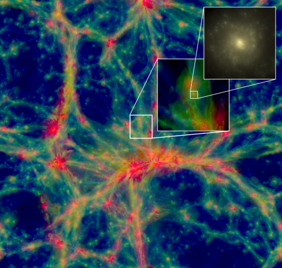Felix Spanier from the Center for Astronomy of the University (ZAH) and his collaboration partners Guido Drexlin and Jonas Kellerer from the Karlsruher Institute of Technology (KIT) have achieved great success in the current application round of the Gauss Center for Supercomputing (GCS): 35 million CPU hours can be used for plasma simulations as part of the Karlsruhe Tritium Neutrino Experiment (KATRIN) whose aim is to measure the mass of the neutrino. The result of this measurement is of fundamental importance, among other things, for elementary particle physics or our understanding of the development of structures in the universe.
The KATRIN experiment is a scientific superlative, the construction of which took about 15 years in international cooperation. KATRIN exploits the so-called beta decay of radioactive tritium gas. This decay produces an electron and neutrino at the same time. The neutrino cannot bedetected. But KATRIN can measure a tiny anomaly in the energy distribution of decay electrons and conclude the mass of the neutrino.
However, the tiny anomaly in the energy spectrum is also influenced by the behaviour of the tritium gas. The decay of the tritium frees up high-energy electrons that can ionize the gas itself, so that it becomes a plasma with special electromagnetic properties. The effect on the electrons to be measured is actually minimal, but in order to measure the mass of the neutrino to the required accuracy of 0.000 000 000 000 000 000 000 000 000 000 3 g, the influence of the plasma must be known indeed very precisely.
Dr Spanier and his colleagues want to try this with elaborate computer simulations. Felix Spanier, whose field is kinetic plasma physics and high-energy astrophysics, has developed the plasma simulation code "ACRONYM" for the past 12 years. The code uses the so-called "particle-in-cell" method, in which electrons and protons are simulated as individual particles and electromagnetic fields are stored in a grid. For the simulation of the KATRIN experiment not only the tritium plasma inside the tank, but also the properties of the walls and the whole chain of atomic and molecular processes (ionization, recombination, etc.) must be considered.
To adapt the simulation to the actual size of KATRIN, the simulation of 50 billion particles spread over 336x336x48639 cells is required, which must be tracked for several million time steps. Only a supercomputer like the "SuperMUC-NG" in Munich can do this, currently at number 9 on the top 500 list of all supercomputers. The group around Felix Spanier can use 1.2% of the computing power for one year. "There are only three systems of this size in Germany that share all disciplines of science. Since we still get such a large share of the computing power, it is a real stroke of luck for our research," Dr Spanier resumes.
The calculation time is used for several individual simulations to simulate the different "operating states" of the KATRIN experiment. A single simulation requires between 250,000 and 1,500,000 CPU hours. By comparison, the latest generation of a world-renowned cosmology simulation, the "Millenium Simulation”, used 2,700,000 CPU hours.
"The high simulation effort is certainly also due to the fact that KATRIN's focus was on neutrino detection. It is therefore not an experiment in which the plasma is to be examined”, explains Dr Spanier. "But the goal at the end is a simple one: what is the distribution of the electromagnetic field in the plasma? The better you know this, the better you can determine the mass of the neutrino in the end."
Additional information
Website of the KATRIN-Experiment: <link http: www.katrin.kit.edu>www.katrin.kit.edu
Homepage of Dr Felix Spanier: <link http: www.ita.uni-heidelberg.de external-link-new-window internal link in current>www.ita.uni-heidelberg.de/~fspanier/
Homepage of the Gauss Center for Supercomputing: <link https: www.gauss-centre.eu external-link-new-window internal link in current>www.gauss-centre.eu/
Zentrum für Astronomie der Universität Heidelberg (ZAH): <link http: www.zah.uni-heidelberg.de>www.zah.uni-heidelberg.de
Contact for the media
Dr. Guido Thimm
Zentrum für Astronomie der Universität Heidelberg (ZAH)
Email: <link mail internal link in current>thimm@uni-heidelberg.de

